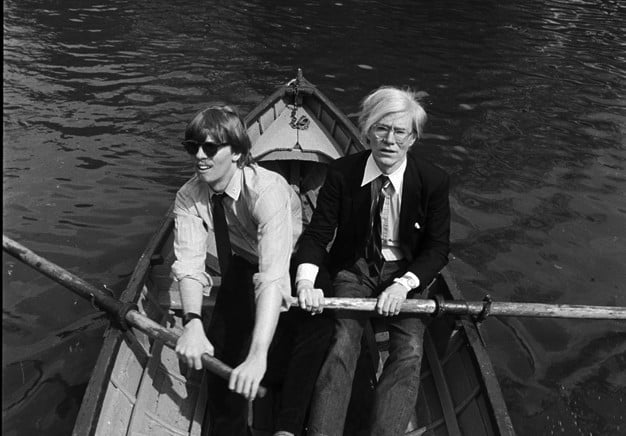
Andy Warhol and Christopher Makos in a rowboat in Paris’s Bois de Boulogne.
Image: Courtesy of Christopher Makos
Photographer and artist Christopher Makos’s world collided with Andy Warhol’s at a dinner party in 1976. Andy was intrigued by Makos’s use of the 35mm camera, his ability to compose a shot, and his knack for being aware of the perfect picture about to happen. Makos, for his part, became close friends with Warhol gaining footing in Warhol’s inner circle and even accompanying the artist on his travels and social outings. Thus, their photographic work began to overlap and they often influenced each other up until Warhol’s untimely death in 1987.
Since that time, Makos, whose photographs are included in the holdings of major museums and private collections, has been involved with numerous books that reflect on Warhol’s life including Andy Warhol’s Exposures (Andy Warhol Books 1979), Andy, (Assouline 2001), and Warhol/Makos In Context (powerHouse Books 2007). It is important, as far as Makos is concerned, that his work continues to capture and accurately share the events, subjects, and legacy of Warhol’s output.
On the occasion of “Andy’s A-List: Warhol Photographs,” the exhibition and sale of Andy Warhol’s photographs, which began Monday on artnet Auctions, Makos discussed with us the context of the photos, and took us on a journey through his years with Warhol, sharing knowledge about how Warhol approached photography, how he got started, and, perhaps most interestingly, how his Superstars had created the first social media platform, before the founders of Instagram and Facebook had even been born.
Andy Warhol, “Molly Ringwald.”
Courtesy of artnet Auctions
artnet Auctions: What was your role in Andy Warhol’s career as a photographer?
Christopher Makos: I knew him 1976-86, when I was working on White Trash (my book), he loved that book. He started with the camera around the time we met, a small Minox camera, then he graduated to a Minolta small autofocus camera.
aa: What motivated him to start taking photos?
CM: He had me as a friend—he didn’t really know how to take pictures or use a camera. We traveled a lot together. The actor Tony Perkins gave me my first camera. I was pretty much self taught, but Andy liked that. Andy was always dabbling. He always appropriated images. And he was always fascinated by taking pictures of himself.
aa: You said that Andy considered photos that you took of him to be photos that he took himself.
CM: That was part of the factory philosophy. It was his camera and his film. That’s how it worked at the factory. The person pushing the button was just a tripod for Andy. I know it’s an alien concept but that was the Factory philosophy. In my case he wouldn’t direct the photo. He knew I knew how to take a quality photo. Whether he was aboard the Concorde going to Europe or on Fire Island.
Andy Warhol, “Arnold Schwarzenegger and Grace Jones.”
Image: Courtesy of artnet Auctions
aa: On your visit to our offices, you and Peter Wise [another Warhol colleague and archivist for Makos] had said that the way photos were handled at the Factory was like the way social media works today. How so?
CM: You could take a picture instantly and see it. With Instant photography, you could share that photo right there. People would take a photo and pass it around and show it to everyone, for fun, to get feedback. The process of taking a Polaroid photo, is totally different from taking a black and white picture.
We had a Factory, it was very much like a platform, to share ideas, or stories. Everybody’s posting pictures of their favorite dish, or baby pictures. At the Factory, people would show pictures to each other. Anyone could go to the factory and present Andy with a play or an idea.
aa: Where were most of these photos that are in the auction taken?
CM: Some were taken on Fire Island. Some of them Western Europe. Most of trips were to Germany, France, London. Contact sheets would come in and Andy would say, “Chris come over.” We’d look at them, I’d say that’s a good picture, and it was as simple as that.
Andy Warhol, “Michael Douglas, Yoko Ono, Jann Wenner, Warhol.”
Image: Courtesy of artnet Auctions
aa: What made a good picture to Andy?
CM: If an interesting moment was captured. Not if the pictures were technically good. You have a lot of examples in your upcoming auction of Andy‘s prints that my studio developed—you can tell by the negative carrier holder. When you see that you know the CM studio did it and to a large extent they were printed by me, so the provenance of those are quite excellent.
aa: Why are there so many taken of him.
CM: He wasn’t a shy person to his close friends. He wasn’t shy around me or Bob Colacello. Like all the famous people that I know, when you are famous, you’re much more at ease with your friends than you are with people you don’t know.
aa: Why did Warhol feel the need to document everything?
CM: He had other people do selfies of him. I have the most cohesive collection of photos of him. Andy was a consummate collector. At the Warhol museum, there are boxes and boxes of time capsules of things that Andy collected. He liked to collect people, watches, jewelry. In the case of photography, he was collecting photographs that could be used one day to make books, that would be ultimately helpful to his work as an artist, as a filmmaker or magazine mogul.
The exhibition, open now through May 8, is available for viewing by appointment only at artnet’s headquarters in the Woolworth Building at 233 Broadway, 26th Floor, New York, NY.
Please reach out to auctions@artnet.com to schedule a viewing.